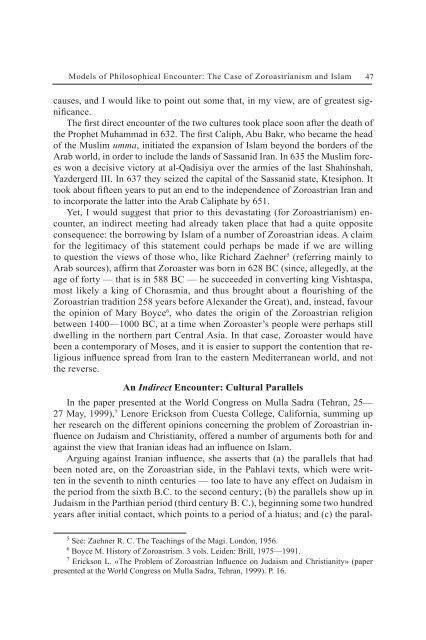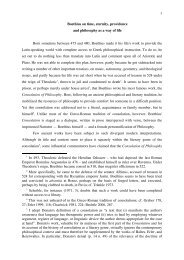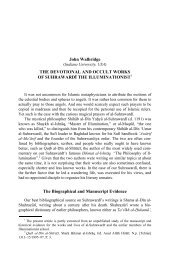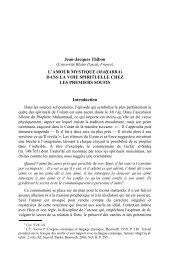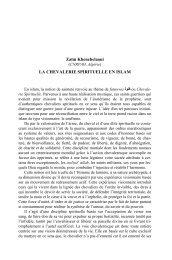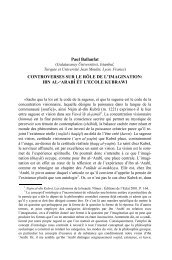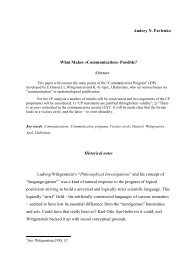Marietta Stepanyants (Institute of Philosophy, Russian Academy of ...
Marietta Stepanyants (Institute of Philosophy, Russian Academy of ...
Marietta Stepanyants (Institute of Philosophy, Russian Academy of ...
You also want an ePaper? Increase the reach of your titles
YUMPU automatically turns print PDFs into web optimized ePapers that Google loves.
Models <strong>of</strong> Philosophical Encounter: The Case <strong>of</strong> Zoroastrianism and Islam 47<br />
causes, and I would like to point out some that, in my view, are <strong>of</strong> greatest significance.<br />
The first direct encounter <strong>of</strong> the two cultures took place soon after the death <strong>of</strong><br />
the Prophet Muhammad in 632. The first Caliph, Abu Bakr, who became the head<br />
<strong>of</strong> the Muslim umma, initiated the expansion <strong>of</strong> Islam beyond the borders <strong>of</strong> the<br />
Arab world, in order to include the lands <strong>of</strong> Sassanid Iran. In 635 the Muslim forces<br />
won a decisive victory at al-Qadisiya over the armies <strong>of</strong> the last Shahinshah,<br />
Yazdergerd III. In 637 they seized the capital <strong>of</strong> the Sassanid state, Ktesiphon. It<br />
took about fifteen years to put an end to the independence <strong>of</strong> Zoroastrian Iran and<br />
to incorporate the latter into the Arab Caliphate by 651.<br />
Yet, I would suggest that prior to this devastating (for Zoroastrianism) encounter,<br />
an indirect meeting had already taken place that had a quite opposite<br />
consequence: the borrowing by Islam <strong>of</strong> a number <strong>of</strong> Zoroastrian ideas. A claim<br />
for the legitimacy <strong>of</strong> this statement could perhaps be made if we are willing<br />
to question the views <strong>of</strong> those who, like Richard Zaehner 5 (referring mainly to<br />
Arab sources), affirm that Zoroaster was born in 628 BC (since, allegedly, at the<br />
age <strong>of</strong> forty — that is in 588 BC — he succeeded in converting king Vishtaspa,<br />
most likely a king <strong>of</strong> Chorasmia, and thus brought about a flourishing <strong>of</strong> the<br />
Zoroastrian tradition 258 years before Alexander the Great), and, instead, favour<br />
the opinion <strong>of</strong> Mary Boyce 6 , who dates the origin <strong>of</strong> the Zoroastrian religion<br />
between 1400—1000 BC, at a time when Zoroaster’s people were perhaps still<br />
dwelling in the northern part Central Asia. In that case, Zoroaster would have<br />
been a contemporary <strong>of</strong> Moses, and it is easier to support the contention that religious<br />
influence spread from Iran to the eastern Mediterranean world, and not<br />
the reverse.<br />
An Indirect Encounter: Cultural Parallels<br />
In the paper presented at the World Congress on Mulla Sadra (Tehran, 25—<br />
27 May, 1999), 7 Lenore Erickson from Cuesta College, California, summing up<br />
her research on the different opinions concerning the problem <strong>of</strong> Zoroastrian influence<br />
on Judaism and Christianity, <strong>of</strong>fered a number <strong>of</strong> arguments both for and<br />
against the view that Iranian ideas had an influence on Islam.<br />
Arguing against Iranian influence, she asserts that (a) the parallels that had<br />
been noted are, on the Zoroastrian side, in the Pahlavi texts, which were written<br />
in the seventh to ninth centuries — too late to have any effect on Judaism in<br />
the period from the sixth B.C. to the second century; (b) the parallels show up in<br />
Judaism in the Parthian period (third century B. C.), beginning some two hundred<br />
years after initial contact, which points to a period <strong>of</strong> a hiatus; and (c) the paral-<br />
5 See: Zaehner R. C. The Teachings <strong>of</strong> the Magi. London, 1956.<br />
6 Boyce M. History <strong>of</strong> Zoroastrism. 3 vols. Leiden: Brill, 1975—1991.<br />
7 Erickson L. «The Problem <strong>of</strong> Zoroastrian Influence on Judaism and Christianity» (paper<br />
presented at the World Congress on Mulla Sadra, Tehran, 1999). P. 16.


